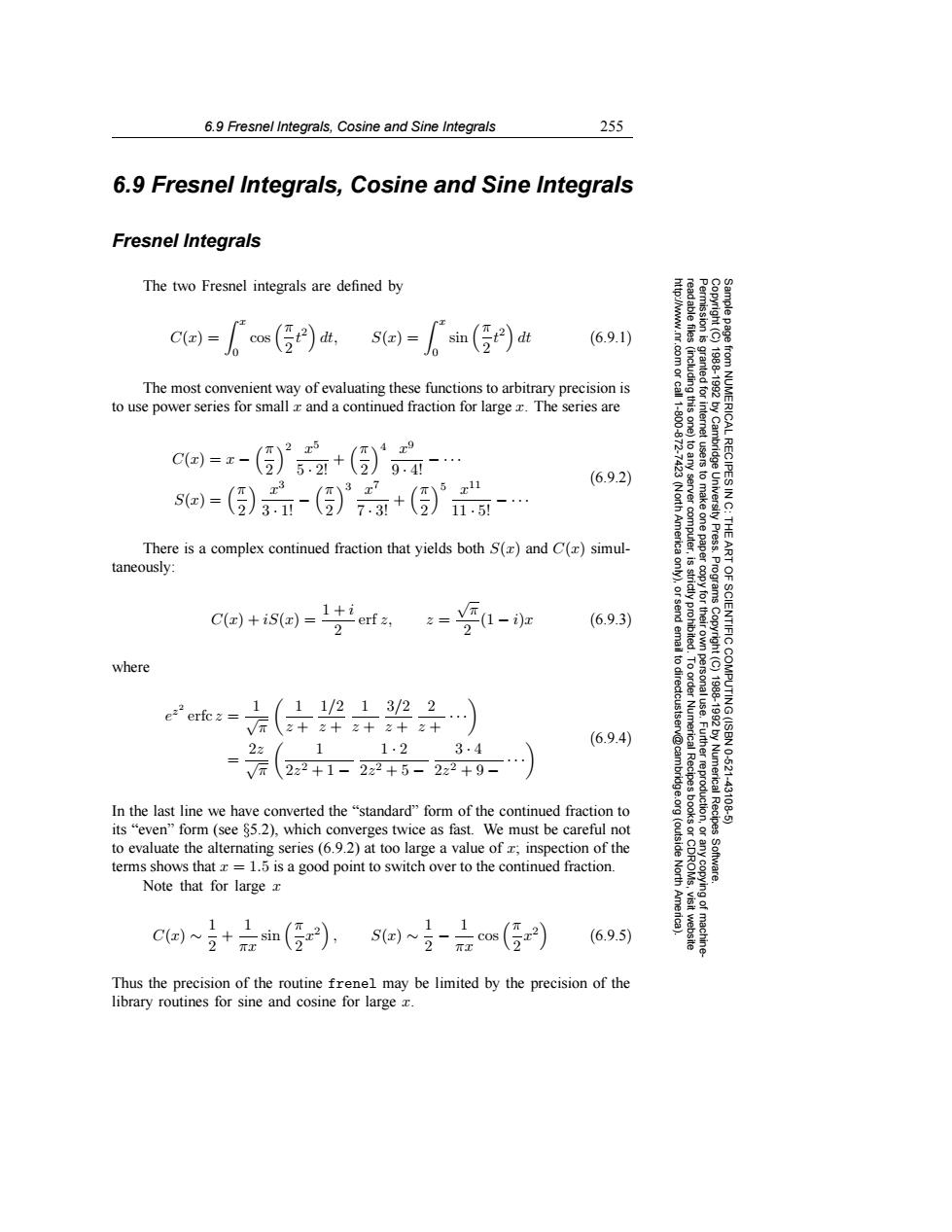正在加载图片...

6.9 Fresnel Integrals,Cosine and Sine Integrals 255 6.9 Fresnel Integrals,Cosine and Sine Integrals Fresnel Integrals The two Fresnel integrals are defined by ca==(后到,s回=血(g9m (6.9.1) 8= The most convenient way of evaluating these functions to arbitrary precision is to use power series for small z and a continued fraction for large z.The series are C(x)=x- /T)2x5 /T)4x9 52+(594 (6.9.2) s-(-(()+( (T3x7 )5x11 (Nort server University 2 11.50-… America Press. THE There is a complex continued fraction that yields both S()and C()simul- taneously: Progra ca+isa=l生af,=9a-0 (6.9.3) 天复 OF SCIENTIFIC( where 61 erfc z 1 11/213/22 2+2+z+2+2十 1920 COMPUTING (ISBN (6.9.4) 22 1 1.2 3·4 222+1-222+5-222+9- In the last line we have converted the "standard"form of the continued fraction to Numerical Recipes 10-621 4310-5 its"even"form (see 85.2),which converges twice as fast.We must be careful not to evaluate the alternating series(6.9.2)at too large a value of inspection of the (outside terms shows that x =1.5 is a good point to switch over to the continued fraction. Note that for large x North Software. c~+am() (6.9.5) Thus the precision of the routine frenel may be limited by the precision of the library routines for sine and cosine for large x.6.9 Fresnel Integrals, Cosine and Sine Integrals 255 Permission is granted for internet users to make one paper copy for their own personal use. Further reproduction, or any copyin Copyright (C) 1988-1992 by Cambridge University Press. Programs Copyright (C) 1988-1992 by Numerical Recipes Software. Sample page from NUMERICAL RECIPES IN C: THE ART OF SCIENTIFIC COMPUTING (ISBN 0-521-43108-5) g of machinereadable files (including this one) to any server computer, is strictly prohibited. To order Numerical Recipes books or CDROMs, visit website http://www.nr.com or call 1-800-872-7423 (North America only), or send email to directcustserv@cambridge.org (outside North America). 6.9 Fresnel Integrals, Cosine and Sine Integrals Fresnel Integrals The two Fresnel integrals are defined by C(x) = x 0 cos π 2 t 2 dt, S(x) = x 0 sin π 2 t 2 dt (6.9.1) The most convenient way of evaluating these functions to arbitrary precision is to use power series for small x and a continued fraction for large x. The series are C(x) = x − π 2 2 x5 5 · 2! + π 2 4 x9 9 · 4! −··· S(x) = π 2 x3 3 · 1! − π 2 3 x7 7 · 3! + π 2 5 x11 11 · 5! −··· (6.9.2) There is a complex continued fraction that yields both S(x) and C(x) simultaneously: C(x) + iS(x) = 1 + i 2 erf z, z = √π 2 (1 − i)x (6.9.3) where ez2 erfc z = 1 √π 1 z + 1/2 z + 1 z + 3/2 z + 2 z + ··· = 2z √π 1 2z2 + 1 − 1 · 2 2z2 + 5 − 3 · 4 2z2 + 9 − ··· (6.9.4) In the last line we have converted the “standard” form of the continued fraction to its “even” form (see §5.2), which converges twice as fast. We must be careful not to evaluate the alternating series (6.9.2) at too large a value of x; inspection of the terms shows that x = 1.5 is a good point to switch over to the continued fraction. Note that for large x C(x) ∼ 1 2 + 1 πx sin π 2 x2 , S(x) ∼ 1 2 − 1 πx cos π 2 x2 (6.9.5) Thus the precision of the routine frenel may be limited by the precision of the library routines for sine and cosine for large x